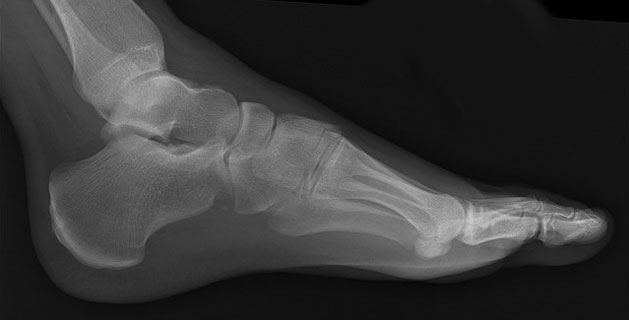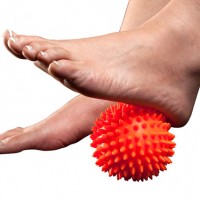Your feet are the essential stabilising system for your body. Similar to the foundations of a building, your feet provide the sensory foundations for most of your daily movements. When your feet are rigid and moving incorrectly, this triggers an entire chain of incorrect movement patterns through your body! This cascading impact of dysfunction is often detrimental to effective movement in the gym, in sport, and in daily life. Thus, your feet must be viewed as the foundations of your health.

Deterioration in the movement of your feet occurs mostly from wearing shoes. The vast numbers of joints in your feet compress slowly over time, and the thick fascia underneath your foot becomes tight and more rigid. In the process, your feet lose the ability to freely move and adapt to the ground. When this occurs, the muscles around your pelvis and lumbar spine cannot activate correctly, no matter how much corrective exercise you do.
A freely moving foot is known as “the listening foot”. It is the ideal that we as movement specialists and exercise physiologists aim to achieve with our clients.
 The listening foot is a term that refers to your foot’s ability to accurately sense and send information to your central nervous system about the surface beneath you and your foot positioning, so that you can unconsciously adjust your body’s alignment and body positioning when needed. Sensory information from the foot influences your balance, posture, and pelvic stability. Your brain interprets the information it receives about the surface you are walking on, which allows your body to unconsciously determine the best placement of your centre of gravity. This, in turn, is essential for the dynamic balance required during everyday life and sport. The foot is highly sensitive as it has a large number of sensory nerve endings at the sole of the feet. Activating a connection called the positive support reflex encourages a strong and stable pelvis, forming the foundation for closed kinetic chain exercises which are commonly prescribed as part of an exercise program.
The listening foot is a term that refers to your foot’s ability to accurately sense and send information to your central nervous system about the surface beneath you and your foot positioning, so that you can unconsciously adjust your body’s alignment and body positioning when needed. Sensory information from the foot influences your balance, posture, and pelvic stability. Your brain interprets the information it receives about the surface you are walking on, which allows your body to unconsciously determine the best placement of your centre of gravity. This, in turn, is essential for the dynamic balance required during everyday life and sport. The foot is highly sensitive as it has a large number of sensory nerve endings at the sole of the feet. Activating a connection called the positive support reflex encourages a strong and stable pelvis, forming the foundation for closed kinetic chain exercises which are commonly prescribed as part of an exercise program.
Effective stimulation of the positive support reflex is influenced by the way the lower leg joints adapt to the floor surface so that your foot can attain accurate sensory information. To access the vital sensory feedback, you need to have good mobility in your feet, ankles, and lower legs to allow your body to adapt to the surfaces you are moving on, and to allow the maintenance of contact with the ground for balance. When the sole of the foot is stimulated by weight-bearing exercises (e.g., squats), the extensors of the knee (quadriceps) and hip (gluteals) are stimulated to bear the load and to prevent these joints from collapsing. Nevertheless, a good transfer of gluteal activation and strength to your sport or daily life cannot be achieved if the sensory information from your foot is poor.
 The rigid foot
The rigid foot
In balance activities, a rigid foot wobbles from side to side, toes gripping the floor, all due to the stiffening of the muscles below the knee. The foot is not effectively sensing and interpreting information about the ground surface, so balance and stability is diminished. The rigid foot is associated with groin, pelvic, and lower back problems, as its dysfunction is related to poor function of the gluteal muscles that support the lumbopelvic region. Rigidity may have developed due to poor stability elsewhere in the body, or from past injuries that have diminished the rotational mobility of the bones of the lower leg (e.g., ankle sprains). In addition, excessive muscle activity around the foot and ankle typically indicates underactive gluteal muscles. Without sufficient gluteal strength and power, rapid lower limb movements are compromised, e.g., jumping, lunging or striding out to stopping yourself from falling.
Do you have the functional rigidity pattern?
Stand on one leg and look at the foot that is in contact with the ground.
- Are the tendons markedly visible of your feet and front of your ankles?
- Are your toes curling under or lifting off the floor?
- Is your ankle making adjustments while your foot maintains broad floor contact?
- Is your whole foot rocking side to side?
- If you close your eyes, does your foot respond by narrowing or tightening?
If you answered yes to any of these questions, you may want to use the following technique to develop a listening foot.

Technique to develop the listening foot
- Sit on a chair with both feet on the floor, with no shoes or socks on.
- Feel the floor surface under your feet. Focusing on one foot at a time, shift the pressure from one part of the sole to another (e.g., heel, midfoot, ball of the foot, toes).
- Place your hands around the top of your lower leg to keep your knee still.
- Move pressure towards outside or your foot while keeping it on the ground. You should find that lower leg rotates with this movement.
- Move pressure the other way (rotation of your lower leg should occur in other direction).
Ensure that your movements are smooth and controlled and as slow as possible, to eliminate any unnecessary tension until you can freely move pressure from the outer to the inner area of the sole of the foot. Repeat as often as you like throughout the day.
 Another method used to develop the listening foot is myofascial release, achieved by self-massaging the sole of the foot with spikey balls, and then with harder balls. This allows the sole of the foot to adapt to the sensory information of the surface of the ball and reduces the rigidity of the foot, which can prevent injury by stimulating improved muscle activation during weight-bearing exercise and daily activities.
Another method used to develop the listening foot is myofascial release, achieved by self-massaging the sole of the foot with spikey balls, and then with harder balls. This allows the sole of the foot to adapt to the sensory information of the surface of the ball and reduces the rigidity of the foot, which can prevent injury by stimulating improved muscle activation during weight-bearing exercise and daily activities.
The listening foot is one of the most essential components of a healthy and functional motor pattern. The connection through the positive support reflex enables you to be grounded, which is necessary for balance and momentum transfer in most sports (e.g., golf, judo). The positive support reflex also encourages a chain of muscular contractions in the legs which assists in achieving the short ground contact times needed for efficient running and jumping. By improving foot mobility and control, you can improve balance and gluteal activation, increase awareness and sensitivity through your feet and ankles, and ultimately improve the quality of your movements in sport and in daily life.
